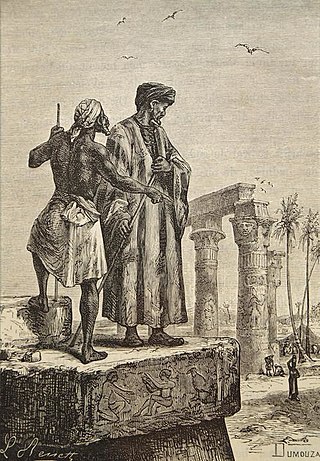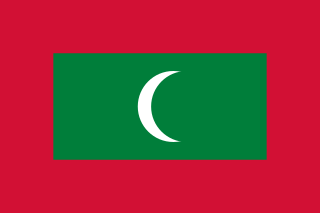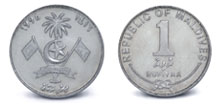
Abū Abd Allāh Muḥammad ibn Abd Allāh Al-Lawātī, commonly known as Ibn Battuta, was a Maghrebi traveller, explorer and scholar. Over a period of thirty years from 1325 to 1354, Ibn Battuta visited most of North Africa, the Middle East, East Africa, Central Asia, South Asia, Southeast Asia, China, the Iberian Peninsula, and West Africa. Near the end of his life, he dictated an account of his journeys, titled A Gift to Those Who Contemplate the Wonders of Cities and the Marvels of Travelling, but commonly known as The Rihla.

The Maldives, officially the Republic of Maldives, and historically known as Maldive Islands, is a country and archipelagic state in South Asia in the Indian Ocean. The Maldives is named after the main island and capital, Malé. The Maldives is southwest of Sri Lanka and India, about 750 kilometres from the Asian continent's mainland. The Maldives' chain of 26 atolls stretches across the equator from Ihavandhippolhu Atoll in the north to Addu Atoll in the south.

The history of the Maldives is intertwined with the history of the broader Indian subcontinent and the surrounding regions, comprising the areas of South Asia and Indian Ocean; and the modern nation consisting of 26 natural atolls, comprising 1194 islands. Historically, the Maldives held a strategic importance due to its location on the major marine routes of the Indian Ocean. The Maldives' nearest neighbours are the British Indian Ocean Territory, Sri Lanka and India. The United Kingdom, Sri Lanka and some Indian kingdoms have had cultural and economic ties with the Maldives for centuries. In addition to these countries, Maldivians also traded with Aceh and many other kingdoms in, what is today, Indonesia and Malaysia. The Maldives provided the main source of cowrie shells, then used as a currency throughout Asia and parts of the East African coast. Most probably Maldives were influenced by Kalingas of ancient India who were earliest sea traders to Sri Lanka and the Maldives from India and were responsible for the spread of Buddhism. Stashes of Chinese crockery found buried in various locations in the Maldives also show that there was direct or indirect trade contact between China and the Maldives. In 1411 and 1430, the Chinese admiral Zheng He 鄭和 visited the Maldives. The Chinese also became the first country to establish a diplomatic office in the Maldives, when the Chinese nationalist government based in Taipei opened an embassy in Malé in 1966. This office has since been replaced by the embassy of the People's Republic of China.

Abraham was a prophet and messenger of God according to Islam, and an ancestor to the Ishmaelite Arabs and Israelites. Abraham plays a prominent role as an example of faith in Judaism, Christianity, and Islam. In Muslim belief, Abraham fulfilled all the commandments and trials wherein God nurtured him throughout his lifetime. As a result of his unwavering faith in God, Abraham was promised by God to be a leader to all the nations of the world. The Quran extols Abraham as a model, an exemplar, obedient and not an idolater. In this sense, Abraham has been described as representing "primordial man in universal surrender to the Divine Reality before its fragmentation into religions separated from each other by differences in form". Muslims believe that the Kaaba in Mecca was built by Abraham and his son Ishmael as the first house of worship on earth. The Islamic holy day 'Eid ul-Adha is celebrated in commemoration of Abraham's willingness to sacrifice his son on God's command, as well as the end of the Hajj pilgrimage to the Kaaba.

The Maldivian rufiyaa is the currency of the Maldives. The issuance of the currency is controlled by the Maldives Monetary Authority (MMA). The most commonly used symbols for the rufiyaa are MVR and Rf. The ISO 4217 code for Maldivian rufiyaa is MVR. The rufiyaa is subdivided into 100 laari.

Islam is the state religion of Maldives. The 2008 Constitution or "Fehi Gānoon" declares the significance of Islamic law in the country. The constitution requires that citizenship status be based on adherence to the state religion, which legally makes the country's citizens 100% Muslim.

Maryam bint Imran is revered in Islam. The Qur'an refers to her seventy times and explicitly identifies her as the greatest woman to have ever lived. In the Quran, her story is related in three Meccan surahs and four Medinan surahs. The nineteenth Surah, Maryam, is named after her. Moreover, she is the only woman named in the Quran.

The red heifer, a heifer which is never pregnant, milked, or yoked, also known as the red cow, is a heifer sacrificed by the priests as a sacrifice to God in the Book of Numbers. Its ashes after being sacrificed and burned were used for the ritual purification of corpse uncleanness caused by an Israelite coming into contact with a human corpse, a human bone, or a human grave.
Kinolhas is one of the inhabited islands of the Raa Atoll administrative division of the Maldives.

The culture of the Maldives is derived from a number of sources, the most important of which is its proximity to the shores of Sri Lanka and South India. The population is mainly Indo-Aryan from the anthropological point of view. Islam is considered the religion of the country and only Muslims can become legal citizens.
The Judiciary in the Maldives has been a systematic institution throughout the history of the nation. It has always been an institution which is under the full control of the Head of State and is still to some degree. However a radical change occurred during the past decades, the introduction of the English legal system into the country; a result of the Maldivian society coming in close contact with the outside world. Consequently, the present legal system of the country is a mixture of not only Shari’ah and customs, but the English legal system also.

The Cheraman Juma Mosque is a popular pilgrim centre in Kodungallur in Thrissur district. According to hagiographical legends, it is claimed that the mosque was built in 629 CE by Malik Bin Dinar.

Hinduism in the Maldives describes the practice of the Hindu religion in the Maldives archipelago. Evidence suggests that Hinduism had a presence in pre-Islamic Maldives. Archaeological remains survive from the 8th or 9th century CE portraying Hindu deities such as Shiva, Lakshmi and the sage Agastya.
Maldivian mythology or Maldivian folklore is the body of myths, tales and anecdotes belonging to the oral tradition of Maldivians. Even though some of the Maldivian myths were already mentioned briefly by British commissioner in Ceylon HCP Bell towards the end of the 19th century, their study and publication were carried out only quite recently by Spanish writer and artist Xavier Romero-Frias, at a time when that ancestral worldview was quickly disappearing.

Dhovemi Kalaminja Siri Thiribuvana-aadiththa Maha Radun or Donei Kalaminjaa was the second king of the Maldives from 1141 to 1166 or 1176 according to the Raadhavalhi and the Loamaafaanu copper plate writings. The Tarikh chronicles however, calls this king Sultan Muhammad al-Adil which is probably the Muslim name of the king after his conversion to Islam in the 12th year of his reign. Later on the title of Dharumavantha (Dharumas) Rasgefaanu or the Benevolent King was bestowed upon him. He is also known as the first ruler of the Theemuge Dynasty. This name was derived from his house's name, Theemuge, some sourced refer to the royal house as the Maalei Dharikolhu. Though it was being called Theemuge Darikolhu they were descendants of the Buddhist Kings of the Lunar Dynasty or Soma Vansa.
Islam is the state religion of Maldives. The 2008 Constitution or "Fehi Qānoon" declares the significance of Islamic law in the country. The constitution requires that citizenship status be based on adherence to the state religion, which legally makes the country's citizens hundred percent Muslim. However residents, tourists and workers in the Maldives are free to be of any religion and practise them in private. However, in 2020, studies found that 0.29% of the population is Christian. During the late 1990s, the Supreme Council for Islamic Affairs issued warnings, cautioning individuals against listening to radio programs broadcast in the Dhivehi language by the Far East Broadcasting Association, headquartered in the Seychelles. In 1998, 50 Maldivian Christians faced arrest and were detained on the prison island of Dhoonidhoo, while foreign Christians suspected of engaging in missionary activities were expelled from the country.

Buddhism was the predominant religion in the Maldives until at least the 12th century CE. It isn't clear how and when Buddhism was introduced into the islands.
Al-Sultana Khadeejah Sri Raadha Abaarana Mahaa Rehendhi or more famously known as just Rehendhi Khadeejah meaning, Queen Khadeejah, was the Sultana of the Maldives from 1347 to 1380. She was one of the few female rulers in the recorded history of Maldives.

Maldivians are an Indo-Aryan ethnic group and nation native to the historic region of the Maldive Islands, present day Republic of Maldives and the island of Minicoy in Union Territory of Lakshadweep, India. Maldivians share one culture and speak the Maldivian language, which is a member of the southern group of Indo-Aryan languages. For ethnographic and linguistic purposes as well as geopolitical reasons, anthropologists divide the Maldivian people into three subgroups.
The caste system in the Maldives is the social stratification system found among the ethnic groups of the island.













